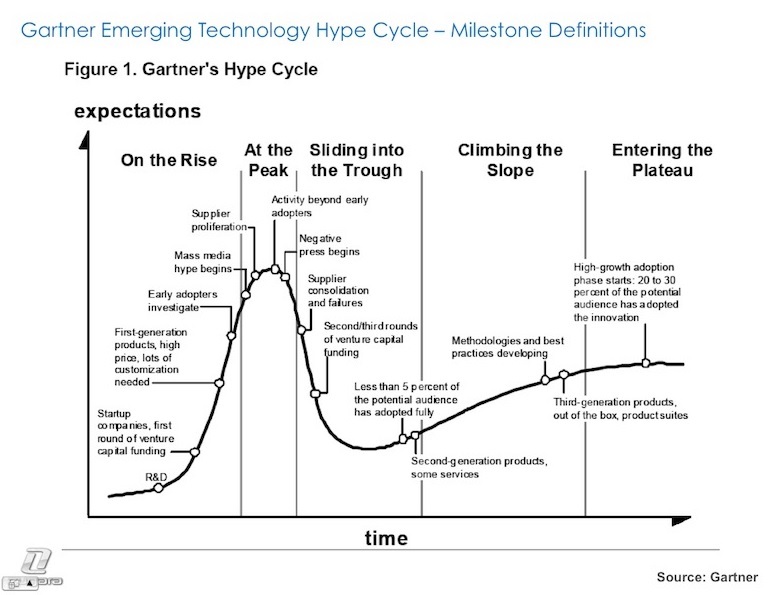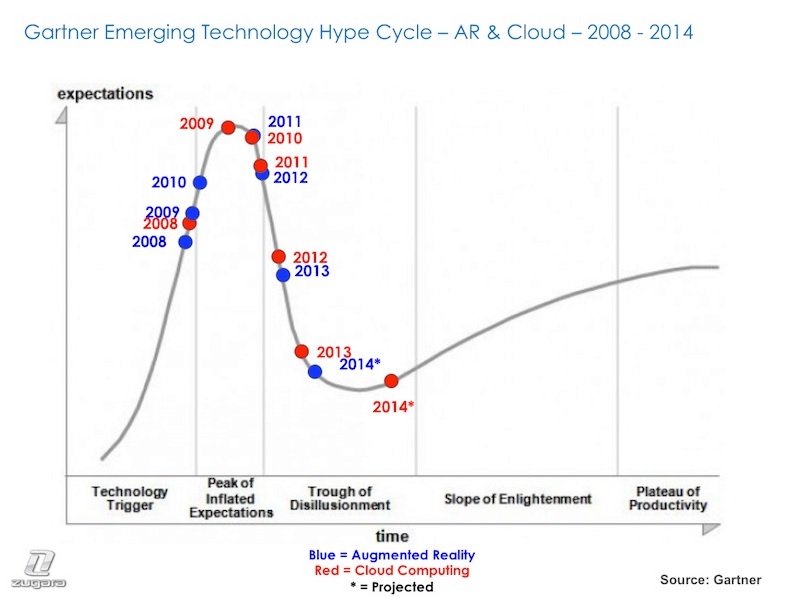A Wall Street Journal article recently proclaimed that “Augmented Reality Is Finally Gaining Traction.” Though AR and similar technologies such as gestural control are gaining traction with brands and customers, why has AR been unable to attract major investment capital to date?
Gartner’s Hype Cycle is one method to track emerging technologies and where they typically raise investment. If you’re not familiar with Gartner’s Hype Cycle, you can view any and all information on the hype cycle on Gartner’s site here. Below is a graphic of the Hype Cycle and relevant milestone definitions.
Augmented reality has been featured on the Hype Cycle since 2008, and Gartner releases an annual update to the Hype Cycle showing how close technologies are to high growth adoption. Below is a graph showing AR’s position on the Hype Cycle from 2008 – 2013. AR’s projected positioning on the Hype Cycle for 2014 is also included.
AR has gone through its “PR Cycle,” and now companies are taking advantage of next-generation technologies to build more powerful AR platforms. What doesn’t sync with augmented reality’s position on Gartner’s Hype Cycle are two triggers that generally happen when companies slide down from the Peak of Inflated Expectations — Industry Consolidation and Second/Third Rounds of Venture Capital Financing.
For comparison, cloud computing’s positioning from 2008 – 2013 is also featured on Gartner’s Hype Cycle below. 2014 is also projected positioning.
Cloud computing technology has been deployed by larger tech players (Amazon, Rackspace, Cisco, etc.), features a diverse ecosystem of well-funded startups, and even has the Bessemer Ventures Cloud Computing Index tracking the leading public cloud computing companies. Though cloud computing has still been thought of as a fad, it’s clear that cloud computing is attracting massive amounts of venture capital.
Where things get interesting (and somewhat confusing) is when you match up augmented reality against cloud computing on Gartner’s Hype Cycle (below).
The data from Gartner highlights a few interesting observations:
- From 2011 – 2013, augmented reality has trailed cloud computing’s position on the Hype Cycle by approximately a year.
- Cloud computing stayed near or at the top of Peak of Inflated Expectations for two years vs. AR’s slower buildup to the Peak and quick entrance into the Trough
With AR & cloud computing having similar trajectories on the Hype Cycle (after their Peak position), why has AR struggled to attract capital investment to date? Here are a few thoughts:
- Augmented reality startups are early stage companies in an early stage industry. AR isn’t the same early stage industry it was five years ago. AR technology has matured, the AR ecosystem has evolved with an increasing number of startups and platforms, and AR companies are focusing on industry-specific problems. Education, retail, automotive, and medical are just a few of the industries ripe for disruption through use of augmented reality technology.
- Augmented reality is a gimmick. Initially, most AR technology was used for pure promotional purposes by brands, creating a perception that AR is a technology searching to solve a problem that doesn’t yet exist. However, like other emerging technologies, AR has become focused and data has followed. eMarketer released a recent study on Mobile Shopping tools where 53% of respondents said that augmented reality was very helpful when shopping for consumer packaged goods. Augmented reality was also the top-rated tool ahead of mobile payments, text alerts, and other mobile specific tools.
- Augmented technology isn’t “ready” yet. AR has been a technology dependent on hardware advancements. First-generation hardware was limited and could only power basic AR experiences. Second-generation hardware such as Kinect 2, Google Glass, and advanced mobile devices is now in the hands of developers and entering the market. As a result, we will likely see more utility-based advancements enter the maturing AR space.
- Augmented reality has been thought of as a ‘feature technology’ and not a platform. Augmented reality startups are building platforms around not only AR, but also other areas such as The Natural User Interface (i.e. Gesture control and recognition using Kinect). At Zugara, our Virtual Dressing Room technology is an example of integrating augmented reality with Natural User Interface technology. Thinking of augmented reality as only a feature technology is misguided and was akin to thinking of social media as just ‘blogs’ back in 2005. Over the years, social media has developed a vast ecosystem and has evolved from the days of Myspace.
- Augmented reality companies themselves are to blame for lack of investment to this point. Too many AR companies release conceptual videos depicting a future of AR that won’t be attainable in 15 years much less 5. Not only does this lead to misguided expectations from consumers and companies, it also leads investors to think future-generation technology (based on these conceptual videos) is closer to reality than it actually is. This also creates a secondary problem in that it diminishes current-generation software even though quite a few AR companies are having success with their current platforms and technology.
Augmented reality shows numerous parallels to the social media space: early technology that had promising engagement data but lacked conversion data, a technology with a few platforms but an underdeveloped ecosystem, “social media will change the world” hype, and so on. But social media has evolved along with a diverse technological ecosystem, and if there’s one area that’s been critical to social media “value,” it’s been social media data and analytics.
Augmented reality technology and platforms will evolve in the same way. As AR platforms continue to gain adoption, they will provide access to invaluable data. Visual data and behavioral response data are just a few forms of data that AR can provide that will be critical for next-generation data analysis. The few VCs that can see “the forest for the trees” understand how valuable this data will be and have placed their bets accordingly.
Matt Szymczyk is CEO and founder of Zugara, a Los Angeles-based augmented reality company focused on multi-channel retail. Since 2008, Zugara has been developing augmented reality retail solutions for the web, events, and in-store retail.
VentureBeat's mission is to be a digital town square for technical decision-makers to gain knowledge about transformative enterprise technology and transact. Learn More





